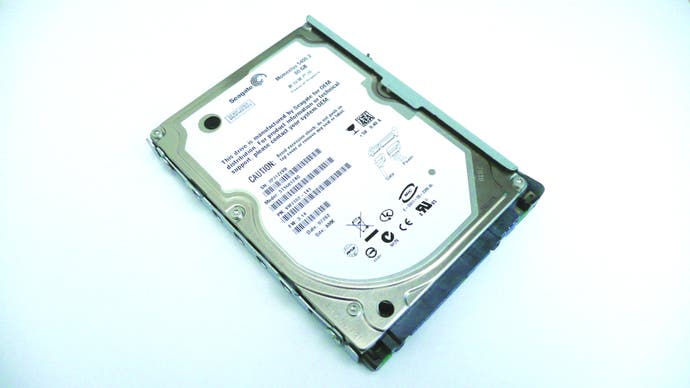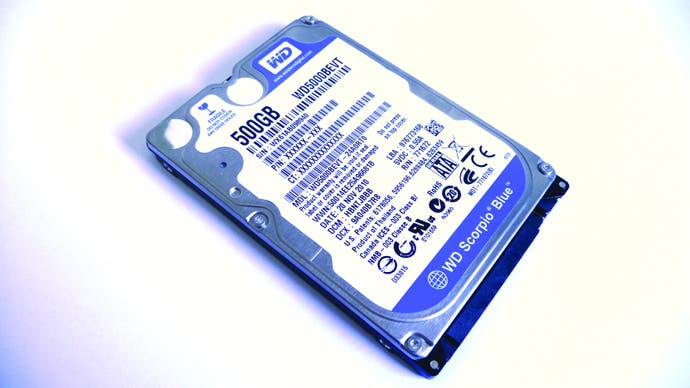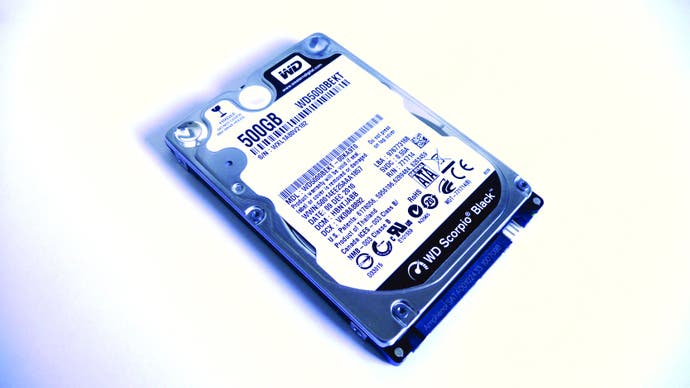PS3 Hard Drive Upgrade Guide
Value, performance and emerging storage tech tested by Digital Foundry.
The price is right. With 500GB external drives now hovering around the £40 mark, there's never been a better time to upgrade the storage capabilities of your PlayStation 3.
For owners of older consoles in particular, upgrading is swiftly becoming an essential requirement. The release of games like Gran Turismo 5 and Mass Effect 2 illustrate that lengthy, massive mandatory installs aren't going to disappear any time soon. In addition to that, downloadable content including full game and HD movie downloads also places demands on the storage you have available for your console.
The PlayStation 3 is designed to run with 9.5mm high, 2.5-inch SATA hard drives - the exact same models found in most modern laptop computers. As SATA is effectively an open standard, you can pair your PS3 with any device that uses the interface. If you want to be particularly insane, you can even hook up desktop drives externally and get a full 2TB of storage. The Xbox 360 uses the same standard of drive, but upgrade options are limited as Microsoft has locked down compatibility to very specific HDDs it licenses.
For PS3 owners choosing a new drive, there are performance considerations to factor in too. Recently we have seen how GT5 ninjas have upgraded their PS3s with ultra-fast Solid State Storage (SSD) drives in order to halve loading times, to give just one example.
In the course of this feature, we'll be covering off a number of different angles to your hard drive upgrade. We'll be targeting a cheap 500GB HDD and putting it through its paces, and we'll also be looking at various drive technologies and directly testing them to see whether the price premium translates into any performance advantage while installing or indeed gaming.
Finally, we'll be looking at the causes of long installs and loading times. Ever wondered why Devil May Cry 4 takes 25 minutes to install, when BioShock copies the same amount of data in just 10? In this feature you'll find out why.
How hard drives work: the basics
First up, a quick primer on hard drive tech. Typically HDDs are defined by two factors according to the base spec: the speed of the drive - typically 5400rpm or 7200rpm - and the size of the onboard cache, which can be anything from 8MB all the way up to 64MB on the latest desktop drives. However, there are several other factors that are of equal, if not higher, importance.
A 5400rpm drive at 500GB spins at the same speed as the basic launch PS3's 60GB drive. However, as the data is more densely packed onto the disk platter, it physically reads more data per revolution. Larger hard drives also use more than one platter - anything up to four in a 1TB drive. So, in an ideal world you'd want a drive that has as few platters as possible with as high a capacity as you can get in order to get the fastest drive.
The other physical reality of hard drives is that as the head of the drive moves towards the inner part of the platter, the amount of area on the disk is smaller, therefore it reads less data per revolution. In very basic terms, the more data you cram onto your HDD, the slower it gets. Any performance testing has to factor this in, because simply benchmarking on a clean empty drive in no way gives an indication of how good the drive is overall.
The final factor is seek time. This is the time it takes for the drive's reading or writing heads to move from one file on one part of the disk to another elsewhere on the drive. When you have Gran Turismo 5 installing over 40,000 individual files onto your hard drive, this is of crucial importance.
What's in your PS3 now?
There have been a large range of different PlayStation 3 SKUs over the years and typically Sony locks in a particular hard drive supplier per model. The chances are that the choice of drive is dictated entirely by the deals the platform holder can arrange with any given supplier, as opposed to any real consideration about how good the drive itself actually is.
One particular developer, which uses the HDD extensively to cache game data in its top-rated openworld game, spoke to us off the record about how the 40GB drive's performance level was significantly worse than the launch model's 60GB disk, requiring a code rewrite to cope with the lower throughput.
A quick look at the drives used by Sony reveals a large degree of variance in the drive spec. The poor performance of the 40GB drive comes into focus here just from a perusal of the basic stats - not only is data less densely packed onto the platter, but also the onboard cache of the drive is a paltry 2MB, whereas the launch model's 60GB drive had four times as much. Seek time - a crucial element in hard drive performance - is also poor.
Based on what we know of the raw specs of the drives, the simple act of moving to a higher density drive should, in theory, give you a performance boost regardless.
The question is just how much performance is there to be gained by paying a premium for a more expensive drive? In the four years since the PS3 launched, has hard drive tech moved on to such a degree that even a cheapo drive will outstrip the performance of your original HDD?


Drives and testing methods
While the SATA interface within the PS3 remains a constant, hard drive tech has improved radically over the years with drive vendors offering a range of models with significantly different performance levels. In our testing we are including an original 60GB PS3 stock drive, along with these carefully chosen alternatives:
- 500GB Western Digital WD5000BEVT: A well-reviewed 5400rpm 8MB cache drive, also known as the Scorpio Blue. Samsung's HM500JI was also considered, but the seek times on this model were faster, it reviewed better amongst the quality PC tech press, and it was just a couple of pounds more expensive.
- 500GB Western Digital WD5000BEKT: 10 pounds more gets you a 7200rpm Scorpio Black drive with double the cache and faster access times. But does the extra cash translate into real-world speed gains?
- 128GB Samsung PM800 SSD: Not the fastest or the newest SSD by any stretch, but this was a solid servant in a Dell laptop for a long time before a 256GB upgrade. The drive was secure-erased in order to restore its original performance level (more on that a bit later).
- 500GB Seagate ST95005620AS Momentus XT: Very expensive at £93, but 32MB of cache, 7200rpm speeds plus 4GB of onboard SSD-style NAND storage makes this hybrid drive irresistible for the benchmarking part of this features. This drive smart-caches the areas of the disk that are the most read, boosting performance considerably on laptops when booting Windows or loading frequently used apps. But can the PS3 benefit from this tech?




So, an interesting range of drives to put to the sword encompassing a range of spec levels and technologies, while the inclusion of the stock PS3 drives gives us a strong indication of what kind of performance increase we can expect, if any.
In testing these drives we cover off the process of installing game data from the Blu-ray drive, plus we use Gran Turismo 5 and BioShock - two games with some mammoth loading times - to judge improvements to in-game performance.







.png?width=291&height=164&fit=crop&quality=80&format=jpg&auto=webp)
